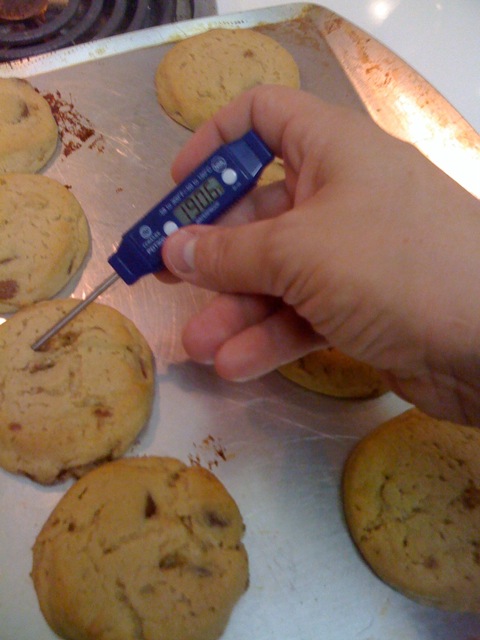That’s what I told Nancy Shute of NPR’s The Salt food blog yesterday when she asked me about whether I really use a thermometer all the time. I do. It keeps me from over cooking stuff, and when making a big meal like at Thanksgiving, taking temps of the bird throughout the day allows for us to plan when we need to prep our side dishes (or fixin’s as they are known in the south).
One of the risks often seen at Thanksgiving, along with cross-contamination and poor cooling of leftovers, is undercooking. Not having or using a thermometer makes it tough to know when a turkey is cooked to a safe temperature – color (either meat or juices) can’t be used to judge doneness, from a microbial standpoint.
Come Thanksgiving, cooks tend to go rummaging in the drawer to dig out the food thermometer; it may be the day we feel most compelled to deploy the slender little probe to keep the killer microbes at bay.
Or so we say. But we may be lying.
In fact, our mastery of turkey tech is pathetic. Just 20 percent of Americans say they regularly use a food thermometer to make sure they have cooked food safely, according to a new survey by the American Dietetic Association and ConAgra Foods. And food safety experts say that a fair number of those people were probably fibbing.
More than half of people admit to never using a food thermometer at all, not even at Thanksgiving, according to a survey by the International Food Information Council Foundation. And those who do, whether it’s to test the turkey or an everyday burger, are probably using it wrong.
Nancy and I chatted about the limitations of a recent study of self-reported thermometer use in the U.S. (people lie) and there’s significant evidence in the literature to back it up.
Ben Chapman, an assistant professor of food safety at North Carolina State University, studies food safety practices like hand-washing and thermometers. When we asked him whether people in general tend to fib about these things, he said, "Oh yeah."
And then he cited a study where he asked 41 people prepare raw frozen breaded chicken fingers in a laboratory. He found that they routinely lied about using the food thermometer provided. Just 10 percent actually used it, and only two used it right. Several cooks never took off the thermometer’s protective sheath. His results were published in the British Food Journal.
"They were like, ‘Oh, here’s a thermometer,’ and they jammed it in there," Chapman says. "It couldn’t possibly have registered anything."
And that’s the people who knew they were being videotaped. Researchers say thermometer use is something that people tend to lie about in surveys because we’ve all heard the public-health messages touting their use, like this new federal campaign, Food Safe Families. Non-thermometer users are probably following cookbook directions like "when the juice runs clear," which Chapman and other food-safety experts say is a myth. So is using color change to gauge whether meat is cooked.
One key step: Take multiple readings. That’s because the various parts of a whole bird like a turkey cook at different rates, and it can be hard to find the deepest or coldest point. Ground meats are also hard to measure with just one poke, because they vary in fat and water content. The goal is to cook each kind of meat until the coolest part reaches the temperature recommended by the USDA.
I relayed that my favorite thermometer is the Comark PDT 300 (right, exactly as shown) – a thermometer that guru Pete Snyder sent me as a gift a few years ago. I like it so much that I bought every extension agent in North Carolina one.
Cooks seeking a super-accurate thermometer need not shell out big bucks for a fancy device. Chapman raves about the Comark PDT 300, a digital thermometer with a super-thin tip. It’s available online and in discount stores for less than $30. Now that he cooks for a 3-year-old, he finds himself using a food thermometer a lot more often. "Not to go all thermometer nerd on you, but I love it," he says.
